Ryan Daly and guest Greg Araujo review the origin of the Star-Spangled Kid (Skyman) and Stripesy from issue #9 of Secret Origins. Then, Siskoid returns for the origin of the Golden Age Flash, Jay Garrick.
Listen to Episode 9!
Subscribe to Secret Origins Podcast on iTunes!
Sample pages from Secret Origins #9, written by Roy Thomas with art by Tom Grindberg and Mike Gustovich (Star-Spangled Kid), and George Tuska and Gerry Acerno, and a cover by Tom Grindberg and Pablo Marcos.
Plus, sample pages from the first Flash adventure in Flash Comics #1 (1940), art by Harry Lampert.
Check out Siskoid’s Blog of Geekery at: http://siskoid.blogspot.ca
“Premonition” (Theme for Secret Origins Podcast) written and performed by Neil Daly.
Additional music this episode: “Come On, Let’s Go” by Ritchie Valens; “Young Americans” by David Bowie.
Leave a comment, Secret Admirers!
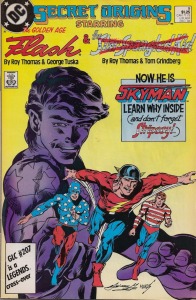
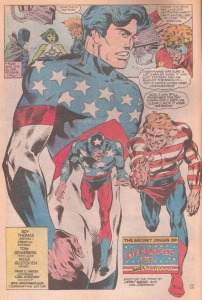
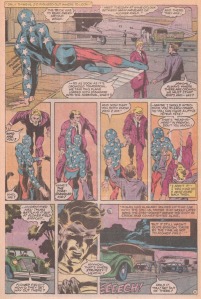
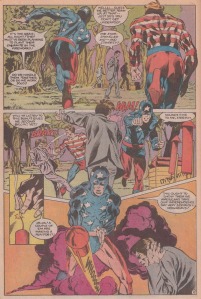
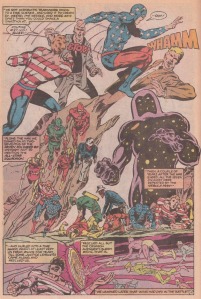
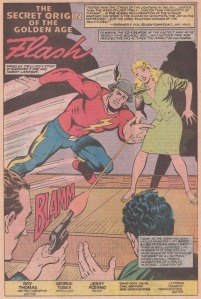
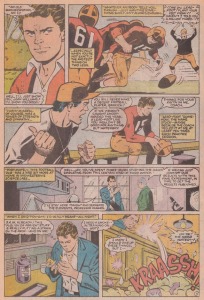
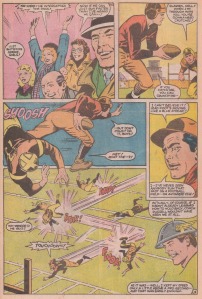
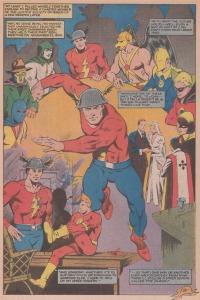
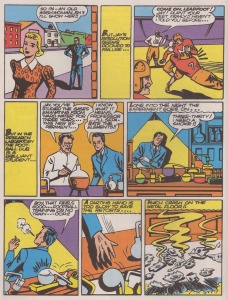
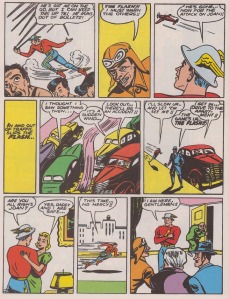
I have family coming in from out of province, so no time to listen to the ‘cast today, but still took a peek: That Shagg teaser was awesome. FINALLY, Shagg makes good.
LikeLike
An example of Google Fu, full Hal Sherman text from Lambiek Encyclopedia:
Harold Sherman, born Harold Sicherman, was a comics artist during the Golden Age of Comics. He was a gag cartoonist and was present at National/DC with ‘The Star Spangled Kid’, created with Jerry Siegel and published in Star Spangled Comics during the 1940s. He created a character called ‘Wonder Woman’ in 1940, which he wanted to sell shortly before the Marston/Peters character appeared. Sherman was also present in DC’s Leading Comics and More Fun Comics, as well as Better Publications’ Startling Comics. He worked on ‘Star Spangled Kid’ until June 1943, when he went into the service. After World War II (circa 1946), he assisted Bernard Bailey on backgrounds of ‘The Spectre’. Later he returned to gag cartooning. He also did work on the Harvey character ‘Spooky’.
LikeLike
Okay. He had life after Star-Spangled, but the latter part of his career is still somewhat vague.
LikeLike
I can confirm the notion about the duo being an “army” IS from the original story in SSC 1, but the line isn’t the same. The Nazi says “Ach… Vat chance did ve haff against those two! Together they could defeat an army in de whole world!”
By the way, the original is a LOT more fun and dynamic. Star-Spangled Kid swinging off a plane propeller, etc.
LikeLiked by 1 person
Thanks, Siskoid. I wonder why they didn’t say, “they could defeat any army in ZE whole world.”
LikeLike
Missed opportunities!
So as you can see, my sister is running late. Listened to the whole thing. I hereby apologize for my drymouth syndrome. I sound like I was sucking on hard candy. (Hm. That’s an unfortunate turn of phrase.)
LikeLike
When I was much younger my father bought me a copy of The Great Comic Book Heroes, which I proceeded to read over and over and over. The Golden Age Flash origin was probably my favorite story in the collection, so when I read this issue of Secret Origins I was shocked how close the Flash origins followed the original story.
It may have been the first time I felt truly disappointed in a comic. Sure I had read bad comics, but I was really bothered by the lack of effort in telling a new story. Definitely the comic version of copying someone else’s work.
I hope everyone enjoyed my podcast debut. So very nervous right up to the point we started recording. Thanks again to Ryan to inviting me to this party.
LikeLike
Even though this was your first recording session, Greg, you technically debuted two weeks earlier on the X-Wing: Rogue Squadron episode of DEAD BOTHAN SPIES. I guess that makes you the Sandman of my podcast guests.
LikeLike
Fun episode! I’ve always had a soft spot for the Jay Garrick Flash ever since my Mom bought me the FAMOUS FIRST EDITION: FLASH COMICS #1 treasury edition off the newsstands, so many decades ago. Who was this guy, who had a name I recognized but looked so different?
LikeLiked by 1 person
Is it okay to admit that Tom Grindberg’s art always reminded me of a sloppy Neal Adams riff? He was clearly trying to evoke Adams, but never quite got a handle on it. I can’t say I was ever a big fan of his work, although it had it’s moments. This cover (and this story, really) isn’t one of them. Greg is right, that splash is pretty bad. Clearly DC hadn’t decided the Golden Age Green Arrow and Speedy were verboten at this point. How could they not realize another Ollie Queen and Roy Harper caused all sorts of continuity headaches, Post-Crisis? Maybe Roy realized and was just keeping quiet, holding on for dear life?!? They even made it out of the last “real” issue of All-Star Squadron, un-retconned…for a while.
And Greg, I appreciate your concern about spoiling Super Mates’ Starman coverage, but I think we’re good. 😉
I never put it together before, but that Flash intro, cribbed directly from Gardner Fox is almost verbatim what Gary Owens utters in his intro to the Flash (Barry Allen) on the much lamented “Legends of the Super Heroes” TV specials. Someone in the production probably had that Famous First Edition handy that Rob mentioned above.
Tuska’s art works much better in this story. Probably because, like Siskoid said, the majority of the Flash’s Golden Age art is pretty rough. It improved vastly when Julius Schwartz became editor in the late 40s and steered the art toward a more illustrative style, with Kubert, Infantino, etc. Harry Lambert’s stuff is actually superior to longtime Flash and JSA artist Martin Naydel, who really had no business drawing super heroes. Great on funny animals, but not the JSA. Oddly enough, Harry Lampbert later became an expert on the card game bridge, and wrote several books on it!
That last page of that Flash story has always bothered me. That is a horrible montage image. As bad as some of the later Who’s Who covers, with characters out of scale to one another interacting somehow. The rest of the story isn’t bad, but that one…phew. I remember as a kid being flummoxed about Jay’s origin. Hard water fumes? The stuff my mom can’t get out of the bath tub? Really?
Chris
LikeLiked by 1 person
Tom Grindberg did some work for Neal Adams’s Continuity Comics prior to this issue of Secret Origins. I’m sure after working in that environment, it’s probably difficult to get rid of the Adams-isms.
LikeLike
Definitely see that Adams influence! Good catch, Chris!
LikeLike
First met Star Spangled Kid in All-Star Comics, with the Bronze Age revival. it was kind of obvious he was being used to replace Starman, which is why I always wondered why Roy didn’t try to make Sylvester a new Starman, in Infinity, Inc? i suppose the Ditko Prince Gavyyn was too recent. Jay Garrick was first observed in a DC house ad, for the Famous First Edition reprint, as well as an ad for Amazing World of DC Comics. Then, I finally got to see him in a JLA/JSA crossover.
I always like Sylvester. DC seemed to struggle with a role for him; but, he was always an interesting guy in a group. Roy got a little mileage out of him, in Infinity, Inc, though he was kind of pushed to the background. I always felt he could have been a stronger figure in that book, though he had moments.
This was one of the hokier stories so far, though I have no idea how much is Roy channeling the Golden Age or if the original story was that goofy. I just wish he had an artist like Mike Parobeck or somebody who could have given it a visual sense of fun. I agree that Stripesy’s perspective would have added a nice wrinkle to the story.
Based on my naval engineering classes, the boiler thing was feasible; but, it a gauge broken off wouldn’t be likely to vent enough steam to keep the boiler from blowing. Also, ducking an escaping blast of steam is a pretty neat trick. One of the ships in my squadron had a sailor who wasn’t so lucky, when a steam pipe burst. But, that’s why they are superheroes!
Jay Garrick was always a fun contrast to Barry Allen and made a great supporting character to Wally, during Mark Waid’s run. I always gravitated to him, over Barry, based on his Silver and Bronze Age appearances. Like the Alan Scott Green Lantern, he always seemed more interesting than his Silver Age counterpart. I’m looking forward to seeing him in season 2 of the Flash.
The story is fine, though Roy doesn’t embellish it much. I do enjoy the Tuska/Acerno art. It’s got a nice lively feel to it.
LikeLike
Tell it, Jeff! Thought the podcast suggests NO ONE is a fan of Star-Spangled Kid, I too liked him quite a bit – in All-Star Squadron certainly, but his Golden Age stories had a sense of cartoony fun. Of course, I have no interest in Infinity Inc. Newsstands didn’t carry the book, so by the time I had access to a comic book store, it was after Crisis, and they were already the Teensiders.
LikeLike
ps In regards the Multiverse. I grew up with the parallel Earth’s so I have a nostalgic attraction to the whole concept. The whole alternate take on things made the JLA/JSA crossovers so great, even when the stories were kind of ho-hum. You still had that legacy feel with anything set on Earth 2. “The Flash of Two Worlds” created that legacy and subsequent stories built upon it, culminating in marriages (including Batman and Catwoman, and Superman and Lois) and children (the Huntress). I felt like post-Crisis lost that legacy, until they brought the JSA out of limbo and built upon their past, again. Crisis took the wind out of Infinity, Inc and All-Star Squadron, for me. It took a lot of work to rebuild that legacy. If DC had started every book from square one, then I could have seen the point of Crisis merging worlds; but, they didn’t and it was a mess for years (some books more than others).
LikeLike
Great points, Jeff, but I think the Crisis, in a way, enhanced the idea of legacy, creating a continuum where, for example, Jay Garrick could directly inspire Barry Allen and Wally West, both. Of course, the idea of legacy was never explored better than in James Robinson’s Starman – even Star Spangled Kid’s legacy was swirling around that series almost from the beginning, with the Kid’s killer, Solomon Grundy being featured so prominently.
LikeLike
The Star-Spangled Kid and Stripesy certainly were an attempt to capitalize on the growing pro-America sentiment of the time. I’m not completely convinced it was a response only to Captain America’s debut, though that likely played a part, especially given another trend that preceded their debut: sidekicks. But what Jerry Siegel did that made the strip unique is that he flipped the script. This time, the kid was the hero and the adult was the sidekick! Robin, Bucky, et. al. gave kids a chance to put themselves into stories and have vicarious adventures with the hero. But here, the kid could actually be the boss!
The original Star-Spangled Kid and Stripesy stories often are silly — and not always in a good way. Siegel was stretched very thin at that point, writing this strip (three stories per month), Superman (one monthly in ACTION COMICS, three bi-monthly in SUPERMAN, one quarterly in WORLD’S FINEST COMICS, plus the daily and Sunday newspaper strip), the Spectre (one monthly) and Red White and Blue (quarterly in WORLD’S FINEST COMICS). I also believe his frustration with mandates from editorial, particularly in regards to Superman, was growing at this point, and combined with the workload had an effect on the quality of his work.
DC apparently had a lot of faith in the strip at the outset, however. The characters got a monthly book all to themselves. (It was a distinction that, at that time, was held by only Superman, Batman and Flash — none of which were monthly, and the latter of which was quarterly and launched only two months before. In fact, I guess that would make the characters the first from DC to launch with a book all to themselves without previously having been a recurring feature in another book.). But moreover, DC gave readers a rare sneak peak of the book in ACTION COMICS #40, the month before the book launched, with an original three-page teaser. The ad twice plugs the book as being from the writer of Superman, even showing a photo of Siegel in the ad, and using images of Superman and Blooey Blue (from Red White and Blue) to push the strip. (Spectre and Red White and Blue also were previously promoted using Siegel’s and Superman’s names, but just as minor house ads, and never with that level of promotion. Hardly anything got that level of promotion in the Golden Age.
I, too, would love to know more about Hal Sherman. I’ve done quite a bit of looking into it and found very little. As pointed out above, I do know he was not killed during service in the war. Jerry Bails’ site credits him with some work for Lev Gleason as well as Bernard Bailey’s Studio in the post-war years. It also credits him with doing work for Harvey Comics and I.W. Publications in the mid to late 190s, in addition to gag cartoons for various publications for many years. Work credits end in the late 1960s.
Also, as Siskoid pointed out, you guys were spot on about the line at the end of the story. Thankfully, no one can blame Siegel for that. He dropped all his non-Superman strips when he was drafted. 🙂
LikeLiked by 1 person
A little late to the party.
I have some problems with this issue. But after listening to the podcast and reading the comments, most will be like flogging a dead horse. But here we go:
1) That cover is just awful for so many reasons. The color scheme is jarring. The ‘surprint’ of Skyman makes little anatomic sense. His right arm cannot do that unless his bicep area is abnormally long or he has 2 elbows. Seriously … look at it … is he Plastic Man?? The running characters in the forefront look stiff, especially Stripesy with that rigid right arm. Just a fail.
2) The Skyman story was something of a fail for me, mostly because Roy Thomas neglects the latter half of Sylvester’s life. As a result, this issue reads more like it has 2 golden age characters rather than one Golden and one modern. It was a fun story to read how Syl and Pat break up a Nazi spy ring but the truth is we have ready many similar origin stories for characters in the 40s. I don’t know if I needed a blow by blow of each nuance of that adventure. Instead, I was hoping to read more about his time with the seven soldiers, this time fighting the Nebula Man, how he dealt with life in the 80s after being a kid in the 30s. I especially was hoping for some talk about his time in the JSA as a member of the ‘Super Squad’ with Power Girl. All that stuff is just blown by and for me, that would be the most interesting part of his tale. That would be like the second part of his origin … his modern origins. Yes it is important to hear why he put on the costume. But there is way more to his back story that could be part of his origins, leading him to being Skyman and Infinity Inc.
3) It doesn’t help that Grindbergs art looks like he drew the pages blindfolded.
4) I am a big Jay Garrick fan and was completely looking forward to this part of the issue when it came out. But, like many preceding it, it is a virtual retelling of the original story. You have talked here about the thought of just reprinting the original stories vs retelling with ‘modern art sensibilities’. But take a look at the Tuska art here. Is there modern sensibility in this retelling? Some panels look like coloring book pages they are so devoid of detail.
Still, you guys made this sow’s ear into something of a silk purse. Thanks to Siskoid for pointing out all the speedster names. I caught Johnny Quick. But that was it!
And Greg, you aren’t the only novice to be part of this podcast. You’ll hear my nervous ramblings in a couple of weeks.
LikeLiked by 1 person
I’m only about 15 minutes in, but it’s bedtime and I might forget to say tomorrow how much I hated the change of name from Star-Spangled Kid, which is cheesy and too long, but classic, to Skyman, which is just blah. What the heck does the sky have to do with patriotism. And try telling all those cowboy heroes that you can outgrow being called ‘Kid’.
Stupid boy.
LikeLike
I think Thomas cribbed the Skyman name from a Golden Age hero that had fallen into the public domain. Still not a good fit, but I believe that was the reasoning.
Chris
LikeLike
Ah, thanks Chris, that makes sense. Can’t let anything GAblie fallow!
LikeLike
Here is a link at Mike’s Amazing World to the original Skyman’s comic:
http://www.dcindexes.com/features/series.php?seriesid=15755
Chris
LikeLike
Yes that Skyman was a lot like Captain Midnight, and Dark Horse published both a Cap and a Skyman series last year with those characters/concepts brought into the 21st century.
LikeLike
Yes, he definitely had that avaiator/hero vibe going, like Captain Midnight and Spy Smasher. I know Spy Smasher is owned by DC, but I had no idea Dark Horse had published those comics.
Chris
LikeLike
I read some of Dark Horse’s Captain Midnight series. Really good book!
LikeLike
The more I think about your anti-Roy Thomas rant from last episode that Shag refers to, the more I side with you, and I started out way on your side to begin with. Whatever stewardship Thomas could lay claim to regarding Earth-2 was rightly revoked when All-Star Squadron was quietly put down to be replaced by the go-nowhere consolation prize of Young All-Stars, while Infinity Inc never caught on despite featuring the artistic talents of Jerry Ordway, Todd McFarlane and Michael Bair. Thomas gets a lot of sympathy for his work being gutted Post-Crisis, but given his possessive attitude, I’m more inclined to point out that he was hardly doing Titans numbers with his little fiefdom, and that he should have added contemporary reading to his slavish, downright plagiaristic “retellings” of Golden Age scripts. Thomas made himself a nostalgia act beginning with the cheesy finale to Kree-Skrull War and dived further into his navel from Invaders onward, so his irrelevance was a self-inflicted, ultimately fatal condition for his scripting career. Audiences no longer wanted his wares, and DC initiated coyote ugly protocols, chewing up the JSA just to get rid of him.
I imagine Thomas inherited Star-Spangled Kid from the Super-Squad, the precursor to Infinity Inc. I don’t recall reading any comics with SSK that meant anything to me, and I tend to dislike DC’s Golden Age stories, so I don’t know if the indifference toward the character is earned or a result of latter day misuse. It does say something that SSK was one of the least interesting Infinitors, which is like taking up a blind taste test challenge for pieces of plain white bread. His costumes were better than Silver Scarab’s, but they were otherwise interchangeable.
As I understand it, because I wasn’t reading the book by that point, the Infinitors were all replaced by duplicates during some other-dimensional adventure (something to do with a fairyland or something?) Thomas got all kill-happy with the plan to eventually restore the team to its default status, but the book got cancelled before that came to fruition. For the best, I figure. I’ve been thinking about it, and it occurs to me that most of the Thomas material I liked was when he was writing for/as Stan Lee while being groomed as his replacement/successor. I see The Invaders as a demarcation point where Roy’s concern for being the next Stan was gone and he began writing more purely for himself, which translated into nostalgic Golden Age fare and mono-dimensional characterization. I’m no fan of pure, unStanulated Thomas, with Infinity Incorporated serving as something of a nadir (since his later, similar Old Timey Big Chillin’ at Marvel never pretended to be anything but.)
I thought for sure that I owned this issue, as I well remember that over-hated-but-still-not-good cover, but if I do I couldn’t find it anywhere (plus Skyman nor the Flash rate any specialized storage cataloging like Detroit Leaguers.) I’m glad, since it spared me that awful sounding/looking Skyman origin. That really was one of the most ill-conceived half-splashes I’ve ever seen. At the end of this story, I still don’t know what Star-Spangled Kid’s deal is. He’s not especially patriotic, he’s not an exceptional fighter or acrobat by super-hero standards, and he’s not childlike (so the adult partner part isn’t exactly relevant.) Also, I’m fine with the Skyman name and costume, but again, why? Does he control air? Does he fly now? Flying isn’t a unique power, you know. Whatever SSKman is, I need more than that to give a spit.
The Flash origin sounds kind of nice, though. I have a higher than average George Tuska tolerance, and I’m surprised to learn Jay Garrick was a proto-Marvel hero who fell backward into super powers and only turned into a mystery man after a round of indulging self-interest. I do like that Jay manages to determine the ethics of super-speed on his own, instead of having some daddy figure pass the law down to him. I knew about the “hard water” bit, but not that Jay was some good-natured but unexceptional schmo who just happened to be breathing in the wrong place at the wrong volume. Jay always seemed like a down to earth sort, and this pedestrian power acquisition bears that out. Also, Stripsey’s great fear is to betray himself and end up buried “where the sun doesn’t shine?” So Stripsey has an angle, at least, seemingly involving latent feelings for his twink– er, partner. “You won’t be the only ones to explode tonight!” This is why Roy Thomas needed to change the dialogue, at least. Such delicious unintentional subtext.
I never had much use for Joan, but I like how she’s being portrayed here. Look, this is an educated, ambitious, affluent career woman during the Depression. She don’t want no scrub– a guy who can get no love from her, hanging out the passenger side of his best friend’s ride hollerin’ at her. She clearly likes Jay, but his game was weak, and she said he needed to shape up or she’d find someone better. That’s her prerogative, and makes her way cooler than most of the JSA wives club (though Molly is still my favorite.)
Count Drunkula’s preference for Earth-2 is wrongheaded for the same reasons you were both right about the New 52 Multiverse. There’s only one Green Lantern and Flash that matter, and they’re on THE Earth. As soon as you have versions from a parallel world, you render Jay Garrick and company as equivalent to Steampunk Batman and Red Son. On Earth One, the JSA is the Greatest Generation super-team who fought World War II without a Superman and originated legacies adored in the modern day. They’re mentors and they themselves evolve. On Earth Two, they’re quaintly racist antique analogues on a memorable episode of Justice League Unlimited, no more or less disposable than that time the ethnic Super Friends joined Strikeforce Morituri on another memorable episode of Justice League Unlimited that nonetheless had no impact on the larger season narrative. Integration puts the incarnations of heroic mantles in the same sandbox, so they interact with, influence, and enrich one another. Earth-2 in the same soda with a dubious added element, like lemon flavoring or vitamins or something. Earth-2 makes Jay Garrick the “other” Flash, the extraneous one you can kill off in an event book. Nobody cares about the greatest players of minor league baseball if they only play a mixed game with the big leaguers once a year, then trot back to their sad little diamonds on the rundown side of town. They’re the Geriatric League of Earth-Silver. Earth-S worked because Captain Marvel needs a whole continuum to himself with its own aesthetic that’s incompatible with the core DC Universe, and because there was only one Shazam. Earth-X worked because the Quality characters don’t function well outside a period setting and are kind of pathetic when grouped with contemporary super-heroes. Earth-2 worked for the next generation, the Huntresses and Power Girls spawned from the alternate histories of “name” heroes who were building their own brands from out of the “spares.” But Flash & Green Lantern? Their only role in the grand scheme was to eventually be sacrificed to build up Infinitors. They deserved better, and Crisis provided.
LikeLike
If you wanted me to read this long-delayed comment in the next listener feedback section, Frank, paraphrasing T.L.C. is definitely the way to my heart.
LikeLike
I agree the cover is a bit of a snoozer. I also found the Skyman story boring. Perhaps I am not patriotic enough to appreciate it. I have always loved the Jay Garrick Flash, though. I met him in the pages of the post-Crisis Flash. He was wise and grandfatherly and had a cool helmet. What’s not to like?
Also, I love most of the music you play on this podcast. I think our tastes are similar.
LikeLike